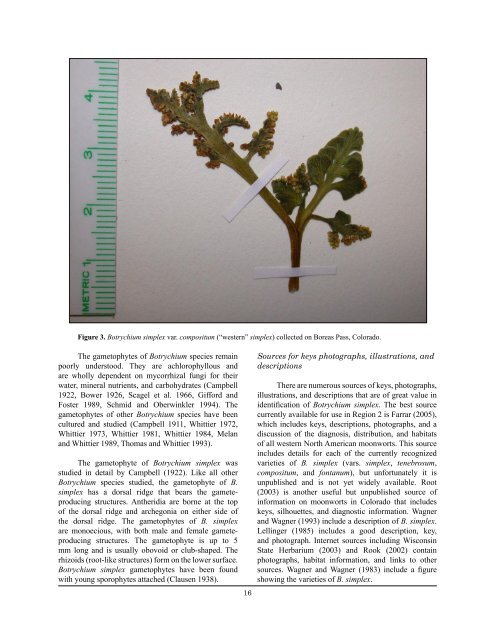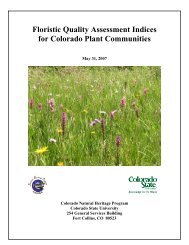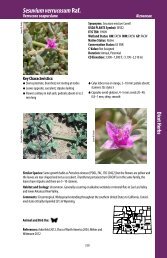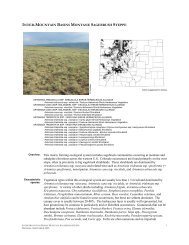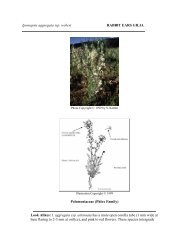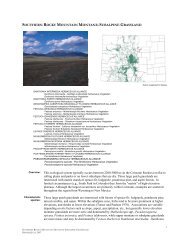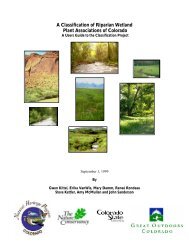Botrychium simplex E. Hitchcock (little grapefern) - Colorado Natural ...
Botrychium simplex E. Hitchcock (little grapefern) - Colorado Natural ...
Botrychium simplex E. Hitchcock (little grapefern) - Colorado Natural ...
You also want an ePaper? Increase the reach of your titles
YUMPU automatically turns print PDFs into web optimized ePapers that Google loves.
Figure 3. <strong>Botrychium</strong> <strong>simplex</strong> var. compositum (“western” <strong>simplex</strong>) collected on Boreas Pass, <strong>Colorado</strong>.<br />
The gametophytes of <strong>Botrychium</strong> species remain<br />
poorly understood. They are achlorophyllous and<br />
are wholly dependent on mycorrhizal fungi for their<br />
water, mineral nutrients, and carbohydrates (Campbell<br />
1922, Bower 1926, Scagel et al. 1966, Gifford and<br />
Foster 1989, Schmid and Oberwinkler 1994). The<br />
gametophytes of other <strong>Botrychium</strong> species have been<br />
cultured and studied (Campbell 1911, Whittier 1972,<br />
Whittier 1973, Whittier 1981, Whittier 1984, Melan<br />
and Whittier 1989, Thomas and Whittier 1993).<br />
The gametophyte of <strong>Botrychium</strong> <strong>simplex</strong> was<br />
studied in detail by Campbell (1922). Like all other<br />
<strong>Botrychium</strong> species studied, the gametophyte of B.<br />
<strong>simplex</strong> has a dorsal ridge that bears the gameteproducing<br />
structures. Antheridia are borne at the top<br />
of the dorsal ridge and archegonia on either side of<br />
the dorsal ridge. The gametophytes of B. <strong>simplex</strong><br />
are monoecious, with both male and female gameteproducing<br />
structures. The gametophyte is up to 5<br />
mm long and is usually obovoid or club-shaped. The<br />
rhizoids (root-like structures) form on the lower surface.<br />
<strong>Botrychium</strong> <strong>simplex</strong> gametophytes have been found<br />
with young sporophytes attached (Clausen 1938).<br />
16<br />
Sources for keys photographs, illustrations, and<br />
descriptions<br />
There are numerous sources of keys, photographs,<br />
illustrations, and descriptions that are of great value in<br />
identification of <strong>Botrychium</strong> <strong>simplex</strong>. The best source<br />
currently available for use in Region 2 is Farrar (2005),<br />
which includes keys, descriptions, photographs, and a<br />
discussion of the diagnosis, distribution, and habitats<br />
of all western North American moonworts. This source<br />
includes details for each of the currently recognized<br />
varieties of B. <strong>simplex</strong> (vars. <strong>simplex</strong>, tenebrosum,<br />
compositum, and fontanum), but unfortunately it is<br />
unpublished and is not yet widely available. Root<br />
(2003) is another useful but unpublished source of<br />
information on moonworts in <strong>Colorado</strong> that includes<br />
keys, silhouettes, and diagnostic information. Wagner<br />
and Wagner (1993) include a description of B. <strong>simplex</strong>.<br />
Lellinger (1985) includes a good description, key,<br />
and photograph. Internet sources including Wisconsin<br />
State Herbarium (2003) and Rook (2002) contain<br />
photographs, habitat information, and links to other<br />
sources. Wagner and Wagner (1983) include a figure<br />
showing the varieties of B. <strong>simplex</strong>.


